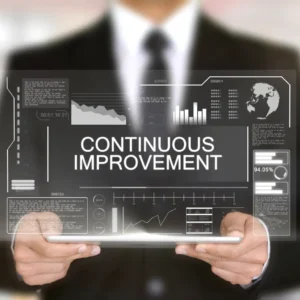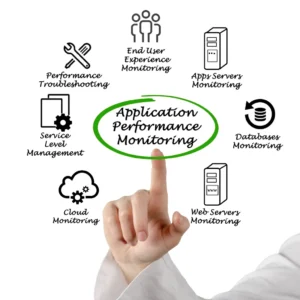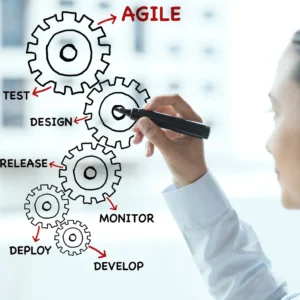
Elevating Excellence
Bot Development in Intelligent Process Automation (IPA) for Seamless Workflows and Enhanced User Experiences
Welcome to an in-depth exploration of “Bot Development in Intelligent Process Automation (IPA).” This article explores the complexities of creating intelligent bots that can easily integrate into automated workflows. From user-centric design principles and advanced scripting techniques to Natural Language Processing (NLP) integration and collaborative development platforms, we navigate the critical facets of developing robust and user-friendly bots.
Unveiling the core elements, we address the significance of error handling, troubleshooting, and security protocols, ensuring the reliability and integrity of bot-driven processes. The spotlight then turns to the convergence of human expertise with machine capabilities in Human-in-the-Loop (HITL) integration, emphasizing collaboration and iterative enhancements.
As we progress, the discussion extends to the dynamic realms of version control, lifecycle management, and the strategic implementation of machine learning for continuous bot training. Each section discusses innovative strategies, governance frameworks, and adaptive protocols, offering a comprehensive guide for business and technical solution providers.
Join us on this journey through the nuances of IPA bot development, where the fusion of automation and human-centric design principles creates intelligent bots that elevate user experiences and streamline complex workflows.
Bot Design Principles
Bot Development in Intelligent Process Automation (IPA): Elevating User-Centric Design
Bot design principles are pivotal in shaping Intelligent Process Automation (IPA) workflows. Focusing on user-centric design approaches for intuitive bot interfaces in IPA workflows is essential. Innovative protocols for creating engaging and user-friendly bot experiences are dynamic strategies that enhance bot interaction and user experience.
Accessibility considerations for diverse user needs in bot development underscore the importance of balancing automation and human-centric design principles in bot interfaces. To achieve this delicate balance, governance frameworks for ethical and transparent bot design practices are crucial. Proactive user feedback mechanisms become vital for iterative bot interface enhancements, ensuring inclusivity and user satisfaction in bot-enabled processes.
Adaptive design principles are essential for evolving user preferences and expectations. Collaborative platforms and tools are pivotal in implementing and managing bot design protocols. These platforms facilitate effective teamwork, ensuring that diverse perspectives contribute to a comprehensive approach to bot development.
In the intricate landscape of IPA, where technology meets human interaction, it is imperative to embrace these principles. Striking a harmonious balance between innovation, inclusivity, and collaboration will propel bot development towards enhanced user experiences and successful automation processes.
Automation Scripting and Programming
Bot Development in Intelligent Process Automation (IPA): Mastering Automation Scripting
Selecting and mastering scripting languages like Python and JavaScript is fundamental in IPA. These languages empower developers to execute advanced programming techniques for handling complex automation tasks seamlessly.
Strategic debugging and testing methodologies are essential to ensure the reliability of automation scripts. The automation script design prioritizes intuitive human interaction, balancing automation and human oversight in development.
Governance protocols guide ethical and transparent scripting practices in IPA, emphasizing proactive error handling and exception management. Innovative approaches to script modularity and reusability enhance efficiency, promoting best practices in code development.
To ensure high-quality code, collaborative platforms and tools are crucial for implementing and managing automation scripts. These platforms facilitate teamwork and knowledge sharing, fostering a collaborative environment for effective script development and maintenance.
In the realm of IPA, where precision and reliability are paramount, mastering scripting languages and adopting strategic methodologies are keys to successful bot development. Incorporating user-centric design and ethical governance ensures that automation scripts align with technical excellence and human-centric principles.
Bot Workflow Logic
Bot Development in Intelligent Process Automation (IPA): Crafting Intelligent Workflow Logic
In IPA systems, developing logical structures is paramount for seamless bot workflows. Strategic decision-making processes within bot scripts optimize automation, balancing automation and human oversight in logic design.
Innovative error handling and exception management protocols in bot logic ensure robust performance. Dynamic protocols for detecting and responding to changes in workflow logic are crucial for adaptability and aligning with evolving business processes.
Governance frameworks guide ethical and transparent decision-making in IPA, incorporating user-centric design principles for an enhanced user experience in workflow logic. Proactive adaptation to evolving business processes is achieved through dynamic workflow logic, enabling efficient responses to changing scenarios.
Adaptive protocols facilitate iterative enhancements based on insights derived from workflow logic. This ensures consistency and efficiency, contributing to the overall success of bot workflow logic design and implementation. In the intricate realm of IPA, thoughtful consideration of these critical aspects ensures intelligent, responsive, and user-friendly bot workflows.
Natural Language Processing (NLP) Integration
Bot Development in Intelligent Process Automation (IPA): Advancing User Interaction through NLP Integration
Incorporating Natural Language Processing (NLP) in IPA workflows elevates user interaction by enabling advanced communication. The strategic integration of NLP algorithms enhances human-bot communication, dynamically addressing language variations and nuances.
Balancing automation and human oversight in NLP-enhanced bot interactions is crucial. Innovative techniques for extracting meaningful insights through NLP analysis ensure a deeper understanding of user input. Governance protocols guide ethical and transparent NLP integration practices, emphasizing proactive consideration of multilingual challenges.
User-centric design principles optimize NLP-enhanced user experiences, while adaptive NLP models facilitate continuous learning and improved language understanding over time. Security measures are pivotal in NLP integration, protecting sensitive textual and verbal data.
In the evolving landscape of IPA, harnessing the power of NLP for intelligent communication enhances user satisfaction and contributes to the overall efficiency and effectiveness of automated processes.
Bot Training and Machine Learning
Bot Development in Intelligent Process Automation (IPA): Empowering Bots through Machine Learning
In Intelligent Process Automation (IPA), proactive bot training utilizes advanced machine learning techniques, ensuring precision and efficiency. Strategic protocols enable continuous learning and adaptation, balancing automation and human oversight in bot systems.
Innovative approaches to data labelling and annotation for training datasets refine bot capabilities. Dynamic strategies emphasize iterative training, enhancing bot performance through ongoing learning processes. Governance frameworks guide ethical and transparent machine learning practices, ensuring the responsible use of IPA.
Proactive implementation of machine learning models optimizes bot performance, aligning with user-centric design principles to enhance user interaction. Adaptive protocols foster iterative enhancements based on insights derived from machine learning, guaranteeing continuous improvement.
In the realm of IPA, data privacy and compliance are paramount. Ensuring robust measures, such as ethical governance and strategic training, safeguards the integrity of machine learning-driven bot development, contributing to both efficiency and ethical responsibility.
Human-in-the-Loop (HITL) Integration
Bot Development in Intelligent Process Automation (IPA): Elevating Collaboration with Human-in-the-Loop (HITL) Integration
Designing interfaces for collaborative Human-in-the-Loop (HITL) interaction in IPA is pivotal for seamless human-bot collaboration. Proactive strategies ensure human oversight in complex decision-making, balancing automation and human involvement in HITL-enabled workflow processes.
Dynamic protocols facilitate collaborative decision-making between humans and bots, enhancing overall efficiency. Innovative approaches to user-friendly HITL interfaces optimize collaboration, adhering to user-centric design principles for an improved user experience.
Governance frameworks guide ethical and transparent HITL integration practices, ensuring security and compliance in HITL-enhanced workflow processes. Adaptive protocols foster iterative enhancements based on HITL collaboration insights, driving continuous improvement and adaptation of automation strategies.
In the evolving landscape of IPA, strategic HITL integration enhances workflow processes and fosters a harmonious collaboration between humans and bots, improving overall system performance.
Error Handling and Troubleshooting
Bot Development in Intelligent Process Automation (IPA): Robust Error Handling and Troubleshooting
Proactive protocols are essential for detecting and resolving errors in bot processes, ensuring the reliability of automation workflows. Dynamic error-handling strategies maintain robustness, balancing automation with human oversight in error detection and resolution.
Innovative approaches to logging and monitoring provide troubleshooting and diagnostics capabilities, facilitating efficient error resolution. Governance frameworks guide ethical and transparent error-handling practices, promoting user-centric design principles to enhance user experience during errors.
Collaborative platforms and tools are pivotal in implementing and managing error-handling processes and fostering teamwork. Adaptive protocols drive iterative enhancements based on error-handling insights, ensuring continuous improvement.
Effective communication during error situations is paramount. Incorporating security measures protects data and processes, assuring a secure and seamless resolution. In the intricate landscape of IPA, meticulous error handling and troubleshooting protocols are vital for maintaining a resilient and user-friendly bot system.
Security Protocols in Bot Development
Bot Development in Intelligent Process Automation (IPA): Fortifying Security Protocols
In IPA, secure coding practices form the cornerstone for robust security in bot development processes. Strategic access controls and user authentication mechanisms balance automation with human oversight, ensuring ethical security practices in bot interactions.
Encryption methodologies safeguard sensitive data throughout bot workflows, addressing the imperative of protecting personal and confidential information. Dynamic security measures continually shield against evolving threats, fostering a secure environment for human-bot interaction.
Governance frameworks guide ethical and transparent security protocols, aligning with user-centric design principles to enhance security. Continuous security monitoring and adaptive measures offer resilience against emerging threats, with adaptive protocols driving iterative enhancements based on security insights.
Ensuring data security at rest, in transit, and during processing is paramount. In the intricate landscape of IPA, meticulous attention to security measures guarantees a trustworthy and protected bot system, instilling user and developer confidence.
Version Control and Lifecycle Management
Bot Development in Intelligent Process Automation (IPA): Streamlining Version Control and Lifecycle Management
Implementing version control systems is imperative for effective bot script management in IPA. Strategic protocols for managing the lifecycle of bot developments ensure a harmonious balance between automation and human oversight.
Innovative approaches to release management facilitate seamless bot updates with dynamic strategies for rollback and version compatibility considerations. Governance frameworks guide ethical and transparent version control practices, aligning with user-centric design principles to optimize the user experience during version updates.
Proactive documentation enhances collaboration in version control processes, fostering efficient teamwork. Adaptive protocols drive iterative enhancements based on version control insights, ensuring consistency and reliability across bot versions in IPA deployments.
In the dynamic landscape of IPA, meticulous attention to version control and lifecycle management ensures a stable and efficient bot system and contributes to a user-friendly and collaborative development environment.
Collaborative Development Platforms
Bot Development in Intelligent Process Automation (IPA): Elevating Collaboration with Development Platforms
Strategic selection and integration of collaborative development platforms are paramount in IPA workflows. Holistically implemented platforms foster team collaboration, balancing automation with human oversight for optimal bot development.
Innovative approaches to version control and code collaboration within development platforms enhance efficiency. Dynamic protocols for documentation and knowledge sharing ensure a cohesive development team. Governance frameworks guide ethical and transparent collaboration practices in IPA development.
User-centric design principles optimize the user experience within development platforms, promoting proactive communication channels for seamless collaboration in bot development. Adaptive protocols drive iterative enhancements based on collaboration insights, ensuring a continuously improving development environment.
We prioritize security and compliance in collaborative bot development environments to ensure the safety of the development process and the final product. In the dynamic landscape of IPA, collaborative development platforms form the backbone of successful and secure bot development endeavours.
Conclusion
In conclusion, our exploration of “Bot Development in Intelligent Process Automation (IPA)” underscores the multifaceted nature of crafting intelligent bots. From user-centric design to security protocols, the intricate dance between automation and human oversight emerges as a defining theme.
The significance of strategic decision-making, NLP integration, and collaborative platforms resonates throughout, emphasizing the pivotal role of these elements in creating harmonious human-bot interactions. Whether navigating error resolution, version control, or HITL integration, the commitment to ethical practices and transparent governance frameworks remains paramount.
As we wrap up this guide, the imperative of continuous learning and adaptation comes to the forefront. Machine learning techniques, adaptive protocols, and proactive strategies ensure that bots evolve alongside changing user needs and dynamic business landscapes.
Ultimately, the success of IPA bot development lies in a delicate balance – a balance between harnessing the efficiency of automation and embracing the insights and creativity of human collaboration. The journey towards crafting intelligent bots reaches its zenith through iterative enhancements, user-centric design, and robust security measures. In the ever-evolving landscape of IPA, this guide is a compass for those steering the course toward innovation, efficiency, and user satisfaction in intelligent process automation.
Related Articles
- Choosing the Right Automation Tool in 7 Steps
- A 9-Step Guide to IPA Implementation: Energise Your Operations
- Navigating the Roadblocks of IPA – The Top 9 Challenges
- AI in Intelligent Process Automation – Unleash the Power of AI
- 9 IPA Examples in Small-Scale Industries
- Power of Intelligent Business Process Automation – Efficiency
- AI Business Process Management: Unleashing the Power
- Business Process Management with AI Integration
- AI for Reengineering Business Processes
- Hyperautomation: Redefining BPM with AI
- The Role of AI in Business Process Modelling
- AI-driven Customer Onboarding – Unleash the Power of AI
- Effective Process mapping in Intelligent Process Automation
- Intelligent Process Automation Adoption – The Best Strategy Guide
- TechInfra in IPA: A Comprehensive Guide
- Elevating Intelligent Automation with Continuous Improvement
- Comprehensive Approach to Cost-Benefit Analysis in IPA
- Vendor Selection in IPA – Comprehensive Guide
- Implementing Agile in Intelligent Process Automation (IPA)
- Scalability and Integration in Intelligent Process Automation
- Cognitive Automation in IPA: Innovating Ethical Efficiency
- Mastering Symphony: Bot Development in IPA Unveiled
- UI/UX Mastery in IPA: Elevating Automation Experiences
- Compliance and Security in IPA – A Guide Ensuring Trust
- Impact of Performance Monitoring and Analytics in IPA
- Driving Success: Data Management in IPA
- Crucial Role: Documentation in IPA Triumph
- Optimizing IPA – Continuous Improvement Strategies






























